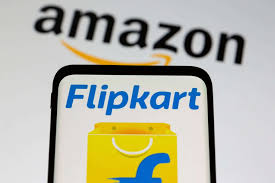India’s e-commerce industry has witnessed phenomenal growth over the past decade. According to a report by Flipkart and Bain & Company, the sector achieved a GMV of $60 billion, surpassing the US in size.
The rapid expansion is driven by:
Growing internet penetration: India now has over 850 million internet users, creating a massive pool of potential online shoppers.
Affordable smartphones: Low-cost smartphones have enabled consumers in rural and semi-urban areas to access e-commerce platforms.
Convenience of online shopping: Doorstep deliveries, easy returns, and digital payment options have boosted e-commerce adoption.
However, despite the remarkable growth in market size, the sector’s expansion rate slowed considerably in 2024. The annual growth rate shrank to 10-12%, almost half of the 20% growth recorded in previous years.
Why Is E-Retail Growth Slowing in 2024?
1. Inflation Weakens Consumer Spending Power
Inflationary pressures have impacted consumer purchasing power, particularly for non-essential products.
Rising prices of essential commodities (groceries, fuel, and utilities) have squeezed household budgets.
Consumers are spending cautiously, focusing on necessities rather than discretionary products such as electronics, fashion, and lifestyle goods.
The higher cost of living is reducing the frequency and volume of online purchases.
2. Stagnant Real Wages Curbing Affordability
Despite India’s economic growth, real wages have remained largely stagnant in 2024.
With minimal salary hikes, consumers have less disposable income.
The affordability of premium products has declined, forcing shoppers to opt for value-based alternatives.
This has led to a dip in high-value online purchases, contributing to the sector’s slower growth.
3. Post-Pandemic Retail Normalization
The post-pandemic return to physical shopping has also slowed e-commerce growth.
During COVID-19, online shopping became the default mode of purchasing due to lockdowns.
However, with restrictions lifted, many consumers have returned to offline stores.
Physical retail is regaining its share, particularly in categories like apparel, footwear, and groceries.
Emerging Trends Driving the Future of India’s E-Retail Market
Despite the current slowdown, three major trends are shaping the next phase of e-commerce growth:
1. Quick Commerce: Speed-First Shopping Revolution
Quick commerce, which offers near-instant delivery of essentials, is transforming the e-retail landscape.
Platforms like Blinkit, Zepto, and Swiggy Instamart are delivering groceries and daily essentials within 10-30 minutes.
The convenience of super-fast deliveries is driving frequent and repeat purchases, especially in metro cities.
This segment is expected to grow at 40-50% annually, becoming a major revenue driver.
2. Trend-First Commerce: The Rise of Fashion-Forward Shopping
Fashion and lifestyle e-commerce is shifting towards trend-first commerce.
Platforms are capitalizing on fast-changing trends, launching new collections weekly.
Social media platforms like Instagram and YouTube are influencing real-time buying decisions through influencer-led promotions.
E-tailers such as Myntra and Ajio are leveraging this model to attract young, trend-conscious shoppers.
3. Hyper-Value Commerce: Affordable Shopping for the Masses
Amidst rising inflation, hyper-value commerce is gaining popularity among price-sensitive shoppers.
Platforms like Meesho and Shopsy are focusing on affordable products and competitive pricing.
Bulk discounts, free delivery offers, and festival sales are attracting budget-conscious consumers.
This model is driving penetration in tier-2 and tier-3 cities, contributing to market expansion.
Future Outlook: What’s Next for India’s E-Commerce Sector?
Despite the temporary slowdown, India’s e-commerce market is projected to grow significantly in the coming years.
Deeper penetration in rural areas: With improved internet access and growing smartphone usage, rural and semi-urban regions will fuel the next wave of growth.
Direct-to-consumer (D2C) boom: Brands are increasingly adopting the D2C model, offering personalized shopping experiences and exclusive products.
AI-powered personalization: E-commerce platforms are using artificial intelligence (AI) to offer tailored product recommendations, enhancing customer satisfaction.
Expansion of digital payments: The growth of UPI, BNPL (Buy Now, Pay Later), and digital wallets will further drive online shopping adoption.
India’s e-retail market has achieved a major milestone, overtaking the US with $60 billion in GMV. However, the sector’s growth slowed to 10-12% in 2024 due to inflation, stagnant wages, and post-pandemic normalization. Despite this, the emergence of quick commerce, trend-first shopping, and hyper-value models will shape the future of e-commerce in India. With deeper rural penetration and technological advancements, the industry is poised for long-term expansion.


Leave a Reply